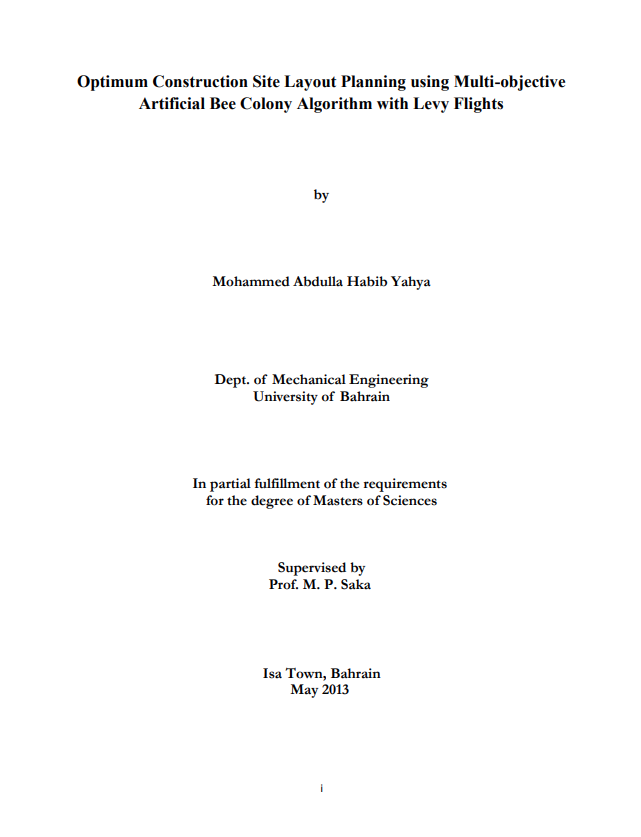Modeling of Late Payments for Contractors Working for MoW Building Construction Projects
Linked Agent
Suliman, Saad , Thesis advisor
Language
English
Extent
[1], 18, 223, [106] pages
Subject
Place of institution
Sakhir, Bahrain
Thesis Type
Thesis (Master)
Institution
University of Bahrain, College of Engineering, Department of Mechanical Engineering
Description
Abstract:
The problem of late payment is considered one of the major issues in the construction industry, it is an important issue that many countries including Kingdom of Bahrain face and it has many consequences on building construction projects. The main objectives of this research are to identify the factors, consequences of delay in payment and their importance, to determine solutions to overcome this issue. To create a prediction model to predict the payment delay in days for Interim payments (Model I) and variation payments (Model V) for MoW building construction projects.
The objectives of the study are achieved through a comprehensive literature review about three main issues; causes of payment delay; effects of payment delay and effective solutions to overcome payment delay. Secondly, information on these issues is collected by surveying experts working in building construction engineering field in both governmental and private sectors. Finally, prediction models to predict payment delay for two types of payments in MoW are developed.
The application of an artificial neural network (ANN) and multi linear regression network (MLRN) to predict the payment delay in days is presented in this work in order to have a more reliable prediction for the actual duration needed for a payment to be processed. This helps in better risk estimation and payment scheduling for governmental projects. The important factors are ranked by their relative importance indecies. Twelve and ten input factors are used for the development of (Model I) and (Model V), respictively, using two MATLAB tools and one Excel analysis tool.
Finally, the study compares the ANN approach with MLRN analysis and concludes that the estimation accuracy of ANN approach is better than MLRN analysis for payment delay as it showed more promising results. The best ANN delay models are found to be Model I-48 and Model V-60, respictively. Both models are developed using MATLAB nftool, Bayesian algorithm and tan-sigmoid function. The study recommends solutions to overcome the payment delay issue in governmental building construction projects. The highest ranked solutions are: Improve and ease the process of payments valuation and certification; Awarding the contract to competent contractors; Proper planning and budgeting of all governmental projects; Proper management of cash flow; Manage to anticipate any risk related to payment issues; and Briefings and meetings prior start of works.
The problem of late payment is considered one of the major issues in the construction industry, it is an important issue that many countries including Kingdom of Bahrain face and it has many consequences on building construction projects. The main objectives of this research are to identify the factors, consequences of delay in payment and their importance, to determine solutions to overcome this issue. To create a prediction model to predict the payment delay in days for Interim payments (Model I) and variation payments (Model V) for MoW building construction projects.
The objectives of the study are achieved through a comprehensive literature review about three main issues; causes of payment delay; effects of payment delay and effective solutions to overcome payment delay. Secondly, information on these issues is collected by surveying experts working in building construction engineering field in both governmental and private sectors. Finally, prediction models to predict payment delay for two types of payments in MoW are developed.
The application of an artificial neural network (ANN) and multi linear regression network (MLRN) to predict the payment delay in days is presented in this work in order to have a more reliable prediction for the actual duration needed for a payment to be processed. This helps in better risk estimation and payment scheduling for governmental projects. The important factors are ranked by their relative importance indecies. Twelve and ten input factors are used for the development of (Model I) and (Model V), respictively, using two MATLAB tools and one Excel analysis tool.
Finally, the study compares the ANN approach with MLRN analysis and concludes that the estimation accuracy of ANN approach is better than MLRN analysis for payment delay as it showed more promising results. The best ANN delay models are found to be Model I-48 and Model V-60, respictively. Both models are developed using MATLAB nftool, Bayesian algorithm and tan-sigmoid function. The study recommends solutions to overcome the payment delay issue in governmental building construction projects. The highest ranked solutions are: Improve and ease the process of payments valuation and certification; Awarding the contract to competent contractors; Proper planning and budgeting of all governmental projects; Proper management of cash flow; Manage to anticipate any risk related to payment issues; and Briefings and meetings prior start of works.
Note
Title on cover :
نمذجة تأخير المستحقات المالية للمقاولين العاملين في المشاريع الإنشائية للمباني في وزارة الأشغال
نمذجة تأخير المستحقات المالية للمقاولين العاملين في المشاريع الإنشائية للمباني في وزارة الأشغال
Member of
Identifier
https://digitalrepository.uob.edu.bh/id/9da681eb-8d3f-4fec-8e0e-ec3594a29a37
Same Subject
